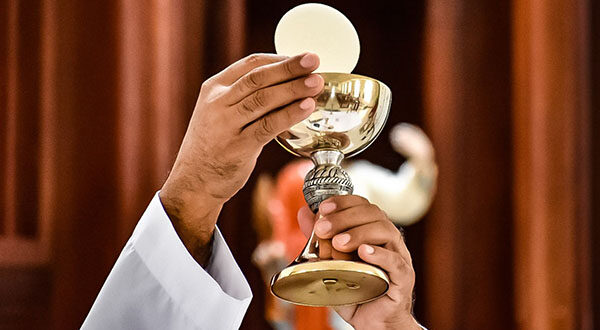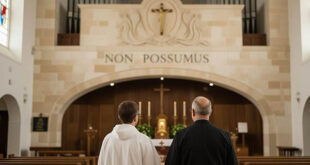Transubstantiation is one of the most profound and beautiful mysteries of the Catholic faith. Over the centuries, it has been a source of contemplation, reverence, and devotion for millions of believers. At its core, it refers to the transformation of bread and wine into the Body and Blood of Christ during the celebration of the Eucharist. Although these elements retain the outward appearance of bread and wine, the Church teaches that their substance has been miraculously changed. But what does this concept really mean, and how can it transform our lives today?
In this article, we will explore the history, theology, and contemporary relevance of transubstantiation. Beyond theory, we will also reflect on how this mystery can enrich our daily spiritual lives and help us live with greater faith and hope.
Transubstantiation in the History of the Church
The concept of transubstantiation is rooted in the words of Jesus at the Last Supper. According to the Gospel accounts (Matthew 26:26-28, Mark 14:22-24, Luke 22:19-20), Jesus took bread, blessed it, broke it, and gave it to His disciples, saying, “This is my Body.” Then He took a cup of wine and said, “This is my Blood.” With these words, Jesus not only instituted a sacrament; He left a lasting legacy for His Church.
From the earliest days of Christianity, the Church Fathers understood that the Eucharist was not merely symbolic but a real participation in the Body and Blood of Christ. St. Ignatius of Antioch (1st century) spoke of the “flesh of Christ” in the Eucharist, and St. Justin Martyr (2nd century) wrote that Christians did not consume ordinary bread and wine, but the Body and Blood of the Lord.
During the Middle Ages, the Church sought to express more clearly what happens during the Eucharistic consecration. It was at the Fourth Lateran Council (1215) that the term “transubstantiation” was first used to describe this mystery. Later, the Council of Trent (1545-1563) reaffirmed this doctrine in response to critiques raised during the Protestant Reformation, stating that although the “appearances” of bread and wine remain, their substance is truly transformed into the Body and Blood of Christ.
What Does “Transubstantiation” Mean?
The term transubstantiation comes from the Latin “trans” (beyond or change) and “substantia” (substance). In Scholastic philosophy, the “substance” of a thing is what makes it what it is, while its “accidents” are the external characteristics that we perceive with our senses. In the case of the Eucharist, transubstantiation means that while the accidents (the appearance, taste, and smell) of bread and wine remain, their substance—what they truly are—has become the Body and Blood of Christ.
This concept is difficult to grasp through human logic. After all, the change that occurs in the Eucharist is not a physical change observable to the naked eye, but a change at the spiritual and ontological level, meaning in the very essence of what the elements are. This is where the mystery of faith comes into play. As St. Paul writes in his letter to the Corinthians: “We walk by faith, not by sight” (2 Cor 5:7). Transubstantiation requires a deep faith in God’s power to work beyond our sensory perceptions.
The Theological Relevance of Transubstantiation
Transubstantiation is not just an abstract theological concept; it has powerful implications for the Christian life. First and foremost, it reminds us that God is not a distant or indifferent being. In the Eucharist, Christ gives Himself to us fully and totally. The act of eating His Body and drinking His Blood is an intimate participation in divine life. By receiving the Eucharist, we unite ourselves with Christ in a tangible and real way.
This mystery also underscores the reality of the Incarnation. Just as God became man in the person of Jesus, He continues to make Himself physically present in the sacraments. The Eucharist is, therefore, an extension of God’s love, who desires to be close to us at all times. It reminds us that Christ is not absent or distant but walks with us and offers Himself as spiritual nourishment on our journey through life.
Theologically, transubstantiation also teaches us something profound about the nature of the sacraments. Sacraments are visible signs of an invisible reality. In the case of the Eucharist, the visible sign is bread and wine, but the invisible reality is the presence of Christ. This mystery challenges us to see beyond what our eyes can perceive and to trust in God’s transformative work in our lives.
Transubstantiation in Daily Life
One of the most beautiful aspects of transubstantiation is its practical relevance. Although it may seem like a purely theological concept, it has the power to transform how we live our faith day by day.
1. The Power of the Eucharist to Transform Our Lives
Each time we participate in Mass, we are invited to enter into this mystery of transformation. Just as the bread and wine are transformed into the Body and Blood of Christ, we too are called to be transformed. The Eucharist offers us the grace to grow in holiness and to become more like Christ. By receiving the Body of Christ, we receive His love, His peace, and His strength to face the challenges of daily life.
In a world that often distracts us with material and superficial concerns, the Eucharist is a reminder that what is most essential is not what we perceive with our senses, but the divine life we receive within. Transubstantiation invites us to seek personal transformation, to allow ourselves to be shaped by grace, and to live as true disciples of Christ.
2. A Call to Worship and Gratitude
Transubstantiation also leads us to an attitude of worship. If we truly believe that Christ is present in the Eucharist, our natural response should be one of reverence and awe. The Church invites us to spend time in Eucharistic adoration, a moment to be silent before the Blessed Sacrament and contemplate the greatness of this mystery.
Moreover, transubstantiation reminds us of the immense gift we have received in the Eucharist, calling us to live in a constant state of gratitude. Each time we attend Mass, we have the privilege of receiving Christ Himself, who gives Himself to us without reservation. This gift should fill us with gratitude and motivate us to live with more love and service toward others, mindful of Christ’s immense sacrifice for us.
3. Practical Applications in Our Spiritual Life
In practice, the mystery of transubstantiation can inspire us to live a life of greater charity and communion with others. As members of the Body of Christ, we are called to be living sacraments to the world—that is, visible signs of God’s invisible love. By receiving the Eucharist, we become participants in Christ’s mission: to bring His presence to every corner of our lives.
This means acting with love and justice, being witnesses of divine mercy in how we treat others. Transubstantiation challenges us to be agents of transformation in our surroundings, living consistently with the faith we profess.
The Mystery That Transcends Time
Throughout the centuries, transubstantiation has been a subject of study and reflection for theologians, saints, and ordinary believers. And while it is a mystery that defies our rational understanding, it remains a source of deep hope and comfort for Catholics of all generations.
In a world that often values the tangible and immediate, transubstantiation invites us to delve into the mystery of the invisible and eternal. It reminds us that, despite our human limitations, God continues to work powerfully in our lives. This mystery of love assures us that Christ is truly present, offering Himself to us so that we may be transformed and strengthened in our daily journey.
Ultimately, transubstantiation is not just a theological teaching. It is an invitation to intimacy with God, to enter into a deeper relationship with the One who gives Himself to us in the Eucharist. May this mystery continue to inspire us to live with greater faith, hope, and love, knowing that in every Mass, the Body and Blood of Christ are offered to us as the spiritual nourishment that sustains us on the journey to eternal life.






